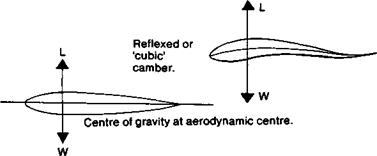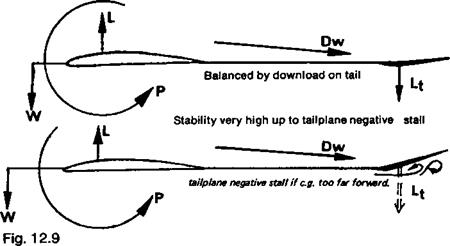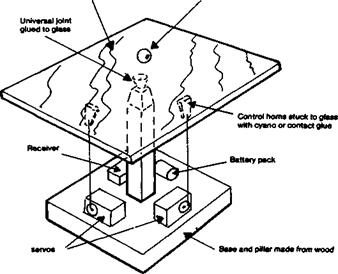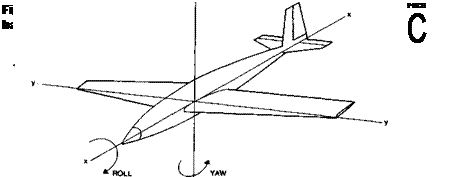STATIC AND DYNAMIC STABILITY
Static stability refers to the stability in flight of an aircraft and has nothing to do with a model standing still. A model with positive static stability will always endeavour to hold its trimmed attitude. However, as mentioned above, some oscillation almost always occurs, the model will swing a little either way from its desired position, and will usually take a little time, and a few oscillations, to settle down. Occasionally, with a statically stable model the oscillations do not die away but continue or even become larger as time goes on. This is dynamic instability. Models with high drag, such as biplanes and most sport aircraft, have good dynamic damping and such problems rarely arise. With very ‘clean’, low drag models, especially sailplanes, gentle ‘phugoid’ oscillations are more common. The model follows a slightly wavy path; nose up, nose down, nose up, nose – down, and this wave-like motion may not be damped of its own accord. In an extreme case the up and down flight may develop into a series of stalls followed by dives and the oscillation may tend to magnify rapidly. Fortunately, the cure is found by increasing the static stability, which tends to damp the motion down as a rule. It also helps to keep the extremities of the model light so that inertia forces at the tail and extreme nose are less likely to take over.
12.13 THE NEUTRAL POINT
As described previously, every wing or wing-like surface in an airstream at a moderate angle of attack has an aerodynamic centre close to the quarter chord point. This applies to fins, tailplanes, foreplanes and such streamlined shapes as struts, wheel spats, nacelles, faired undercarriage axles, etc, etc. Even long, slender forms such as arrow shafts or fuselages have an aerodynamic centre and this is normally close to the quarter length position for moderate angles of attack.
If the structure of a model is fairly stiff, it may be treated as a fully rigid body. Then it is possible to regard the entire aircraft as one object which produces lift and drag at some fixed point equivalent to the aerodynamic centre of the whole. The exact position of this point may be found by finding the a. c. of each separate component first, then, with an allowance for the efficiency of each part as a producer of aerodynamic force (area, angle of attack, body shape etc, and whether or not in the wake of another component), the total effect of all may be added and the aerodynamic centre of the entire aircraft found. As with a wing, providing the airflow is not generally separating the centre of forces so found remains in one place at all usable flight trims.
It has already been pointed out that, for a model to be in trim, the total of all pitching moments on it, at any place on the fore and aft centre line, must be zero. Hence, when the aerodynamic centre of the aeroplane is located, if it is in trim the pitching moments of all the various components will total zero at this point
For stability, however, it is necessary that if there is a disturbance of equilibrium, causing a nose-down or a nose-up pitch, then a corrective pitching moment should appear. Then, a nose-up disturbance causing an increase of the total lift force at the aerodynamic centre of the model must automatically produce a nose-down moment, and vice versa, a nose-down upset must produce a nose-up moment.
An unstable aircraft will produce the reverse, a nose-up pitch will produce a nose-up moment, making the situation worse, and again, vice versa.
A neutrally stable aircraft, when pitched either way, will produce no pitching force either way, leaving the attitude to be determined by chance gusts and random disturbances of the air. In Figure 12.7 a symmetrical wing was shown, in trim, with zero pitching moment and the centre of gravity exactly at the aerodynamic centre of the wing. A disturbance of such a wing would produce no pitching moment either way, because symmetrical wings have no pitching moment (unless stalled). Evidently, the condition of neutral stability for an entire aircraft just described is exactly similar no corrective force arises either way if the model pitches.
If the centre of gravity of any aeroplane or glider is at the aerodynamic centre of the entire aircraft, neutral static stability is the result For this reason, the aerodynamic centre of an aeroplane is termed the neutral point Figure 12.10 shows the results if the centre of gravity is at behind or in front of the neutral point in a disturbance. In Fig. 12.10a the c. g. is at the neutral point A gust throwing the model into a climbing attitude causes an increase of the total lift force on the whole model. The c. g. and lift are still acting at the neutral point and no pitching moment results. With a nose-down upset, again, there is no corrective force.
In Figure 12.10b, the c. g. is aft of the n. p. Now a nose-up disturbance produces an increase in lift and this produces a nose-up pitching moment Vice versa for the nose-down disturbance; the lift is reduced and the nose-down pitch is worsened.
It follows that for static stability the situation of Figure 12.10c is essential. The centre
|
MOMENT APPEARS. C. Centro of gravity ahead of the neutral point STATIC STABILITY Fig. 12.10 Aerodynamic centre, neutral point, and the centre of gravity. |
 |
 |
of gravity of the aircraft must be in front of the neutral point Then a nose-up disturbance produces an increase of lift behind the c. g. and this tends to restore the normal trimmed and balanced flight attitude. A nose-down change produces a decrease of the lift aft of the c. g., and a nose-up moment arises. This applies to all model layouts, as in Figure 12.11.

















 Neither balanced nor stable
Neither balanced nor stable
